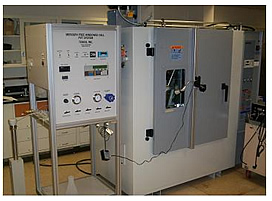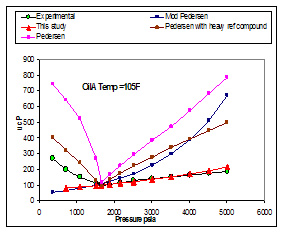The vast in-place ANS heavy oil resource can help meet the increasing energy demands of the United States. However, there are problems associated with heavy oil production, such as very high viscosity, which makes the crude oil difficult to produce and transport. These problems hinder economical production of viscous oils on the North Slope.
Heavy oil reservoirs tend to be low-energy, low-gas/oil-ratio systems with high viscosities. They cannot be produced, transported, and refined by conventional methods. Some of the commonly considered heavy oil recovery methods include processes such as steamflooding, in-situ combustion, and miscible gas injection. Success of these processes is critically dependent on accurate knowledge of PVT parameters and fluid phase behavior under a variety of thermodynamic conditions. Practical field experience on the slope has shown poor mobility, emulsification, cavitation, and sand production during pumping; injectivity limitations to solvent and gas floods; asphaltene precipitation; and formation damage during heavy oil recovery operations. Each of these problems is directly related to the present lack of understanding of the complex phase behavior and phase changes involving heavy oil-gas-solvent-asphaltene phases at high temperature and pressure. Consequently, research in this project is focused on fluid characterization, phase behavior in the presence of hydrocarbon solvents, oil viscosity behavior, minimum miscibility pressure, swelling behavior, and solids (asphaltenes and waxes) precipitation focused exclusively on ANS heavy oils. Using these experimental data, along with thermodynamics and transport theory, phase behavior modeling and basic reservoir simulations can be carried out to improve production from ANS heavy oil reservoirs.
Results
An extensive literature review has been conducted on ANS heavy oils and related production problems. The review demonstrated that the success of possible production approaches is critically dependent on accurate knowledge of the oil’s PVT relationships and phase behavior under a variety of thermodynamic conditions.
Crude oils from various ANS heavy oil pools were compositionally characterized to aid in phase behavior and viscosity modeling. Heavy oils are difficult to flow under normal operating conditions; hence viscosity reduction is an important step in achieving commercial production rates. Engineering this entails being able to model the viscosity of the oil under reservoir conditions, so simulations of various production scenarios are being conducted. Viscosity models were studied and applied to heavy oil systems to test their predictive capability. Viscosity measurements were carried out at reservoir conditions to supplement these modeling efforts.
EOS tuning was performed on the West Sak heavy oil data available from previous studies. Consequently, a completely tuned EOS was developed using the tuning performed by CMG WINPROP and the available experimental data. The tuned EOS was then used to do reservoir simulation studies to test the various EOR strategies. Accordingly, work is being carried out using carbon dioxide (CO2) as an EOR agent. The initial results are very encouraging. Furthermore, it was proposed to test a few more EOR solvents, such as enriched CO2 and a miscible injectant.
Benefits
The main goal of this project is to complete a phase behavior (experimental and simulation) study of the ANS viscous oils. With this study, basic reservoir (oil recovery) simulations are being conducted to improve production from ANS heavy oil reservoirs. This will help in developing a better understanding of the nature of these oils, which will further help in developing efficient production strategies, such as EOR. Results from the work are expected to be of direct and immediate value to several ANS operators that are currently developing heavy oil resources. Development of heavy oil resources is very important for continued economic operation of the Trans-Alaska Pipeline System, as this could supply the needed fluid volume to make up for the dwindling light oil production from the North Slope. ANS heavy oils are also low in sulfur and heavy metals content; making them attractive refinery feedstocks. Heavy oil development also offers opportunities for carbon sequestration. Substantial volumes of CO2 will be available on the ANS with future planned gas sales. ANS heavy oil resource development could thus be an answer to the challenge of meeting increasing U.S. oil demand while developing opportunities for CO2 sequestration.
Summary
Research in this project is directed specifically towards experimental and simulation studies to understand the PVT and viscosity behavior of various representative ANS heavy oils in the presence of solvents, gases, heat, and precipitating phases and to demonstrate the application of this knowledge toward a better understanding of formation plugging and poor fluid mobility in reservoirs and pipelines. The experimental results of the phase behavior and viscosity of ANS heavy oils will be used in EOS tuning and viscosity modeling, respectively. Results from this work will be used in reservoir-scale simulations that can be regarded as a backbone of heavy oil development on ANS.





